Taking teamwork to a new level
Asking clients for input and allowing staff members to plan the new facility made for a winning combination at Magrane Pet Medical Center.
Twelve team members filed into the architect's office. Many were wearing scrubs, some were doctors straight from surgery or nurses between appointments. They gathered around the architect's desk-crammed into a place meant to seat only six-and interviewed him.
"The experts we worked with probably would have preferred to talk with just the owners," says co-owner Dr. Ron Doversberger. "But we wanted everyone to be involved every step of the way." Staff members jumped right in, asking about the architect's fees and strategies for staying on budget and requesting photographs of other projects the firm had designed, Dr. Doversberger says.
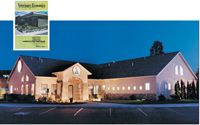
For the second time in 30 years, Magrane Pet Medical Center won a Veterinary Economics Hospital Design Competition award. At left: The practices 1973 Hospital of the Year cover feature.
This scene played out many times during the 24-month planning and building process for Magrane Pet Medical Center in Mishawaka, Ind. Team members interviewed contractors, chose color samples, arranged the floor plan, and more. The result? A 2003 Veterinary Economics Hospital Design Competition Merit Award. The overall impact? A practice that all 27 team members, from doctors to kennel attendants, are happy to work in-and that clients and patients love to visit.
The force is with them
The building process reflects a focus on teamwork that makes task forces a way of life at Magrane Pet Medical Center. "We create task forces for whatever need exists," says co-owner Dr. Kathleen Neuhoff. "Team members attack and resolve the issue, then the task force disappears. This idea stems from a team autonomy concept that we've been developing for close to 20 years, and it works phenomenally well."
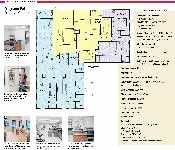
Award-winning floor plan
In all, five crews tackled the building project, focused on such issues as site selection, design, construction, and public relations. "All staff members are invited to volunteer for a task force," says technician Jenny Sutherland. "It's great to participate, because the owners take all our suggestions seriously and appreciate input from anyone."
To get started, the owners closed the practice for the day and all employees met offsite to discuss the different facets of building a practice. "Over the next few months, we had people visiting other practices for ideas, attending the Veterinary Economics Hospital Design conference, completing a demographic study, talking with the developer, interviewing architects, and helping in every facet of the design," Dr. Doversberger says.
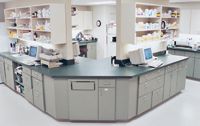
The lab and pharmacy, directly behind the exam rooms, become one large room with the open pass-through in the middle. This set-up gives privacy while being practical.
During that time, the task forces met weekly-or more frequently-to stay on track. Some crews were more active at different times in the process. For example, the site crew spent more time doing legwork in the beginning. As the project neared completion, the moving crew kicked into gear.
"Nearly every employee was involved in the process at some point," says Dr. Neuhoff. "And we found that staff members had a much better grasp of what would improve their areas than the owners did." Dr. Neuhoff says staff members provided many important design ideas, including an extra large, padded run in the ICU, large bins to hold prescription vials, and a hanging quilt to cover the fold-up exam table in the comfort room.
The doctors say that architect Wayne Usiak has said in retrospect that Magrane's broad-based involvement really was the key to their success-even if dealing with 12 staff members at once was a bit hairy. "At the time, involving our whole staff complicated the process, but we made better-quality decisions," Dr. Doversberger says.
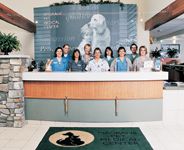
A mural at the front desk emphasizes compassion, quality, service, and pets and people as the practices main concerns. A photo of a boy and his dog completes the picture.
Client-focused design
"Before we went through the design process, I thought that pet owners only cared about how well we cared for their pets," says Anita Shultz, pet care specialist and surgery nurse. "I was wrong. Our clients had a lot to say about our hospital's design."
So it's a good thing the team held focus groups to learn what features clients would love-and which ones they didn't like. "We've held client focus groups off and on for nearly 20 years," says Dr. Neuhoff. "So it seemed natural to invite 30 clients-20 came-to give input on our practice design."
Clients came up with such ideas as a memorial pet walk, a comfort room with a private exit for client privacy and euthanasias, outside seating, extra-wide parking spaces to help get pets out of cars, a textured floor to keep pets from slipping, a heated entry sidewalk, a retail area near the waiting and check-out areas, a window for boarded cats to view the birds outside, and a custom 12-foot-square mural depicting the human-animal bond. The team implemented all of these ideas.
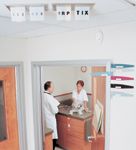
Staff members use two communication systems to call team members to exam rooms. The assistant call display is mounted to the ceiling, and the doctor identification tabs are adjacent to each exam room door.
"One client suggested putting bench seating in the exam rooms," says Dr. Neuhoff. "The client thought that dogs would be able to climb onto the benches, then onto the exam tables by themselves. I never would have thought that would work, but it does."
The team also told the client focus group about ideas they were planning, such as a "show" exam room that would give clients a view of high-tech diagnostic equipment in the lab and let them observe ultrasounds and other procedures. Equal parts loved the idea, thought it was OK, and really disliked the idea. The practice owners decided to go ahead with their idea, but changed the floor plan to provide a semi-private viewing alcove to give clients the choice to watch. They say they generally draw the biggest crowd when doing pregnancy ultrasounds.
Design through the ages
Magrane Pet Medical Center was a 1973
Veterinary Economics
Hospital of the Year under the ownership of Dr. Harry Magrane. But after two renovations, the doctors decided it was time to start fresh-and go bigger.
"We'd simply outgrown our old facility and lot," says Dr. Richard Goebel, a co-owner who acquired the practice in 1979 from Dr. Magrane. "For a while we leased three parking spaces from a neighboring land owner just to make things work. Finally the time came to make a move."
The old practice featured just four exam rooms-a limiting factor the doctors knew they needed to correct, given that exam rooms produce more income than any other hospital area. "We were known to perform exams in the handicapped bathroom, aisles, and the treatment room when necessary," Dr. Neuhoff says.
More must-haves: More space for recovering pets and a spot for Dr. Kimberly Morrow's desk-she joined the practice as an owner right before the decision to build. "They had difficulty finding space for me," she says.
Dr. Doversberger says asking clients and staff members for ideas made planning the project much easier. "And our designer, Wendy Wheeler, somehow managed to blend the wealth of client and staff wants and needs into a stunning facility," he says.
Even with nearly perfect planning, a few mishaps occurred. For example, a client called Dr. Doversberger to report a pink UFO outside the practice-in-progress. Sheets of soon-to-be-installed pink plastic foam insulation got caught in a windstorm and traveled into a nearby pond, across the property-and even into nearby traffic.
The reminder of another mishap is set in stone-literally. Shultz, the surgery nurse, took time to admire the view of the pond during building. Unfortunately, she forgot she was standing in the soft concrete that would eventually hold a client reflection bench. Her footprints remain to this day as a reminder of the building process.
And team members say nothing could have prepared them for the emotions they would feel on moving day. "I kept remembering everything that happened during my 18 years in the old facility-from the way I'd grown at work to things that happened to me in my personal life," says Shultz. "Many of our team members have worked at Magrane's for years, and we're very attached to the practice. The building project went well because we were so emotionally involved, and it was rocky at times for the same reason."
Dr. Morrow agrees that making the change was a bit uncomfortable in ways. "We'd been in such tight quarters for so long, we were ready to bust out," she says. "But in such a big place we literally got lost. We had to walk in circles to find each other. It was a little scary not having your co-workers surrounding you."
Over time staff members got used to the new building-and learned to use the intercom system. And all seven exam rooms are regularly filled to capacity just one year after moving in.
The best part, the owners say, is that staff members and clients knew they were part of building something great. "The key to a great building project," says Dr. Doversberger, "is employee and client involvement. Without them, we couldn't have built such a terrific practice."
Editors' note: Preparing to build? The 2005 Veterinary Economics Hospital Design Competition is the perfect place to showcase your new facility. To enter, call (800) 255-6864, ext. 111, or e-mail ve@advanstar.com.